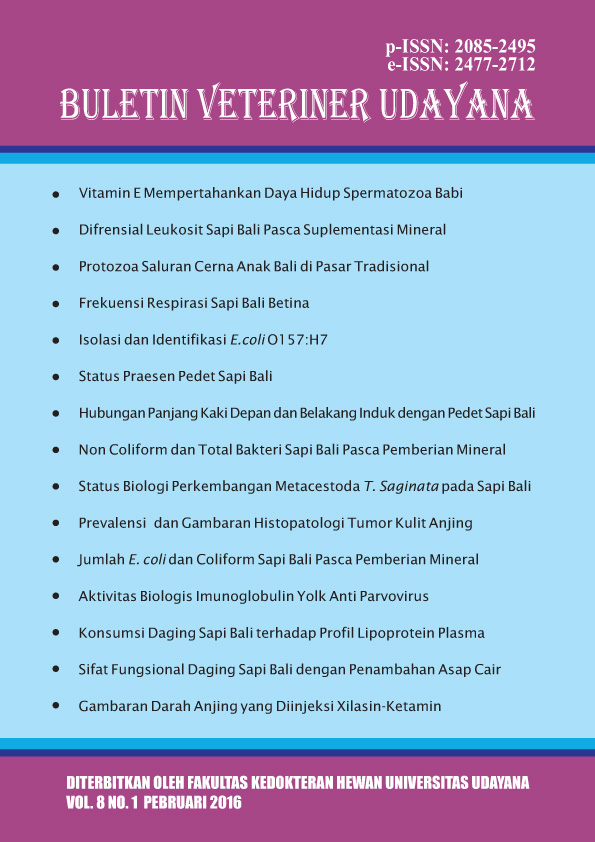IMPROVEMENT OF FUNCTIONAL PROPERTIES OF BALI BEEF (M. Longissimus dorsi) THROUGH ADDITION OF LIQUID SMOKE POST MORTEM AT DIFFERENT RIGOR TIMES
Abstract
In order to improve meat quality of bali cattle, application of post harvest technology is still needed to be developed. One of post mortem technologies application is addition of liquid smoke as a binder for increasing meat functional properties of bali cattle especially pH and water holding capacity. This study aimed to improve meat functional properties of bali cattle through addition of different levels of liquid smoke at different rigor times. This research utilized the muscle of Longissimus dorsi (L. dorsi), from bali cattle aged three years. Completely randomized design in factorial pattern of 5 x 8 with five replications was used in this research. Factor 1 was the percentage of liquid smoke of 10% concentration (0%, 0,5%, 1,0%, 1,5% and 2,0%, w/w) and factor 2 was rigor times (1, 2, 3, 4, 5, 6, 7, and 8 hours post mortem). Parameter observed was pH and water holding capacity. The results showed that pH was decreased and water holding capacity was increased with increasing the level of liquid smoke. Furthermore, by increasing the rigor time, pH values were decreased while water holding capacity was not significantly differ. It can be concluded that liquid smoke could increased the meat functional properties of Bali cattle especially pH and water holding capacity.
Downloads
References
Abustam E, Likadja JC, Ma’arif A. 2009. Penggunaan asap cair sebagai bahan pengikat pada pembuatan bakso daging sapi bali. Pros Seminar Nasional Kebangkitan Peternakan. Badan Penerbit Universitas Diponegoro.
Abustam E, Ali HM. 2011. Pengaruh jenis otot dan level asap cair terhadap daya ikat air dan daya putus daging sapi bali prarigor. Proc. of Nat. Sem. On Zootechniques for Indegenenous Resources Development. Pp. 233-236.
Gregorio CC, Antin PB. 2000. To the heart of myofibril assembly. Trends in cell Biology, 10(9): 355-362.
Hardianto L, Yulianta. 2015. Pengaruh Asap Cair Terhadap Sifat Kimia dan Organoleptik Ikan Tongkol. J Pangan dan Agroindustri, 3(4): 1356-1366.
Janloo SM, Dolezal HG, Gardner BA, Owens FN, Peterson J, Moldenhauer M. 1998. Characteristics of dark cutting steer carcasses. Anim Sci Res Rep, pp. 28-31.
Kompas. 2010. Harga sapi merosot. Impor daging tidak terkendali. Kompas 6 Mei, p:19.
Kusnadi DC, Bintoro VP, Al-Baarri AN. 2012. Daya ikat air, tingkat kekenyalan dan kadar protein pada bakso kombinasi daging sapi dan daging kelinci. J Aplikasi Teknologi Pangan, 1(2): 28-31.
Malmfors G, Brendov B. 1987. The problem of dark cutting in veal. 33rd Int. Congress of Meat Sci. and Technol. Helsinki, 3(4): 112.
Merthayasa JD, Suada IK, Agustina KK. 2015. Daya ikat air, ph, warna, bau dan tekstur daging sapi bali dan daging wagyu. J Indo Med Veterinus, 4(1): 16-24.
Mikulik A, Bibova J, Zemanova D, Dvorak Z. 1987. The occurrence and rapid identification of DFD bulls. 33rd Int. Congress of Meat Sci. and Technol. Helsinki, 3(4): 144.
Miller MF, Carr MA, Ramsey CB, Crocckett KL, Hoover LC. 2001. Consumed thresholds for establishing the value of beef tenderness. J of Anim Sci. 79: 3062-3068
Setiadji BAH. 2000. Asap cair tempurung kelapa. Asap cair sebagai pengawet alami yang aman bagi manusia. PPKT, Yogjakarta.
Steel RGD, Torrie JH. 1991. Principles and procedures of statistics. McGraw-Hill, Book Co. Inc, New York.
Suwiti NK, Suastika P, Swacita IBN, Piraksa W. 2013. Tingkat kesukaan wisatawan asing di Bali terhadap daging sapi bali dan wagyu. Proc Seminar Nasional Sapi Bali, pp:42.
Yunus M. 2011. Teknologi Pembuatan Asap Cair dari Tempurung Kepala Sebagai Pengawet Makanan. J Sains dan Inovasi, 7(1): 53-61.





